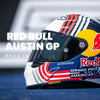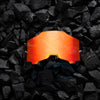


FLY Racing is proud to present the all new Formula helmet, one of the most advanced motocross helmets ever created. This technologically advanced helmet will redefine helmet performance and safety expectations.
The Formula development team spent years of collaborated research and design with industry leading doctors, scientists, and physicists from around the world to produce the innovative Adaptive Impact System (AIS).
This collection of technologies is a high-performance ecosystem of structural design and energy mitigating materials. Each layer of the Formula AIS was carefully fine-tuned to achieve the goal to provide superior head protection from the widest possible range of potential real-world impacts.
Impact Energy Cells maximize absorption of low speed linear and rotational impacts. Their unique shape and maze-like structure allow them to compress and shear. This slight movement maximizes absorption of low speed linear and rotational impacts reducing overall brain stress.
These Energy Cells are made of RHEON, an “active” strain-rate sensitive material that efficiently absorbs and dissipates energy as it deforms. Invented by Dr. Dan Plant, RHEON’s adaptive chemistry reacts instinctively to control energy and change its behavior depending on the severity or direction of an impact.


Like a crumple zone, Conehead technology absorbs and dissipates impact forces more effectively than traditional EPS helmet liners. Created by physicist Don Morgan, Conehead technology produces more progressive energy absorption through a broader range of impact scenarios.
The Formula has six critical zones of Conehead EPS. Each zone has a uniquely fine-tuned combination of EPS densities to more progressive response to impacts specific to that region of the helmet.
Studies have shown that the majority of impacts occur on the forehead or side of the head. To help combat these impacts, the Formula development team incorporated lower density expanded volume EPS (thicker EPS) in these critical zones. This expanded volume EPS provides improved suspension for impacts.


The Formula’s first line of defense is an extremely strong and lightweight 12K carbon fiber shell. 12K carbon fiber refers to 12,000 carbon filaments per band. Carbon fiber is strongest when it is flat. Wider carbon fiber bands woven together produce a flatter result with less dips and rises inherent in a woven material.
The reduction of these dips and rises creates less areas for resin to pool. Less resin equals less weight. The result is an extremely lightweight shell with superior penetration resistance to common 3K carbon fiber.

FLY Racing is proud to present the all new Formula helmet, one of the most advanced motocross helmets ever created. This technologically advanced helmet will redefine helmet performance and safety expectations.
The Formula development team spent years of collaborated research and design with industry leading doctors, scientists, and physicists from around the world to produce the innovative Adaptive Impact System (AIS).
This collection of technologies is a high-performance ecosystem of structural design and energy mitigating materials. Each layer of the Formula AIS was carefully fine-tuned to achieve the goal to provide superior head protection from the widest possible range of potential real-world impacts.

Impact Energy Cells maximize absorption of low speed linear and rotational impacts. Their unique shape and maze-like structure allow them to compress and shear. This slight movement maximizes absorption of low speed linear and rotational impacts reducing overall brain stress.
These Energy Cells are made of RHEON, an “active” strain-rate sensitive material that efficiently absorbs and dissipates energy as it deforms. Invented by Dr. Dan Plant, RHEON’s adaptive chemistry reacts instinctively to control energy and change its behavior depending on the severity or direction of an impact.

Like a crumple zone, Conehead technology absorbs and dissipates impact forces more effectively than traditional EPS helmet liners. Created by physicist Don Morgan, Conehead technology produces more progressive energy absorption through a broader range of impact scenarios.
The Formula has six critical zones of Conehead EPS. Each zone has a uniquely fine-tuned combination of EPS densities to more progressive response to impacts specific to that region of the helmet.

Studies have shown that the majority of impacts occur on the forehead or side of the head. To help combat these impacts, the Formula development team incorporated lower density expanded volume EPS (thicker EPS) in these critical zones. This expanded volume EPS provides improved suspension for impacts.

The Formula’s first line of defense is an extremely strong and lightweight 12K carbon fiber shell. 12K carbon fiber refers to 12,000 carbon filaments per band. Carbon fiber is strongest when it is flat. Wider carbon fiber bands woven together produce a flatter result with less dips and rises inherent in a woven material.
The reduction of these dips and rises creates less areas for resin to pool. Less resin equals less weight. The result is an extremely lightweight shell with superior penetration resistance to common 3K carbon fiber.

Designed developed after several years of focused efforts and crucial feedback from top...

UNPARALLELED PERFORMANCE FOR THE MODERN RACER. Developed by our engineers in Californ...

Riders who know what they want and what they need will instantly recognize the performa...

Wishlist are temporary to this session Only . your product(s) will not be saved permanently.

